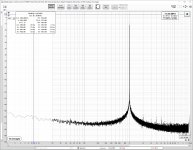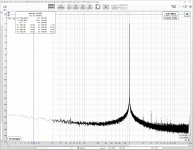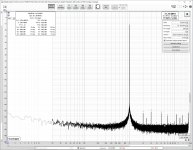Here is another report about high H3 in the notch section:
Below is the notch section at 0dB position with 450mV, 1kHz input for 4.5Vrms output (the notch is at 10kHz).

When the notch select is switched to the 1kHz position, the 1kHz fundamental is attenuated by 30dB, but the 3rd HD is increased by about 8dB:

So with the notch engaged, the H3 is at about -117dB, quite a bit far from the -150dB residual THD spec. Or did I miss anything?
Another issue for me is that the although the A-weighted noise level on the pre-amp section roughly meets spec, the 1/f noise is pretty significant, and the 1/f corner frequency is relatively high. Without some kind of high-pass filtering, it is difficult to even get a stable noise RMS reading. The high 1/f corner frequency also limits its usefulness in evaluating power-line induced noise.

Below is the residual noise with 1M point FFT averaged 4 times and then 1/24 oct smoothed (60dB gain position, scope shot shown above):

I bought the uncalibrated kit. I guess most people order the kit with the assumption that when adjusted properly, it should perform at to close to the advertised performance of a 'factory' calibrated and tested unit. The adjustment of the notch pots is straightforward, although there is a bit of interactions between the frequency and the gain pot. However, the single-turn pots are too 'touchy' to adjust to the exact frequency and gain with the resolution of an AP. Since the author compares the APU favorably to an APX555, it would be a reasonable assumption that people use the APU as a companion device to an AP, and use the latter to adjust the notch filters to perfection. The author really should have used multi-turn pots on those locations. Given the time and equipment needed for the adjustment and performance verification, the additional cost of a 'factory' calibrated and tested unit seems justified. Caveat emptor.
Below is the notch section at 0dB position with 450mV, 1kHz input for 4.5Vrms output (the notch is at 10kHz).
When the notch select is switched to the 1kHz position, the 1kHz fundamental is attenuated by 30dB, but the 3rd HD is increased by about 8dB:
So with the notch engaged, the H3 is at about -117dB, quite a bit far from the -150dB residual THD spec. Or did I miss anything?
Another issue for me is that the although the A-weighted noise level on the pre-amp section roughly meets spec, the 1/f noise is pretty significant, and the 1/f corner frequency is relatively high. Without some kind of high-pass filtering, it is difficult to even get a stable noise RMS reading. The high 1/f corner frequency also limits its usefulness in evaluating power-line induced noise.
Below is the residual noise with 1M point FFT averaged 4 times and then 1/24 oct smoothed (60dB gain position, scope shot shown above):
I bought the uncalibrated kit. I guess most people order the kit with the assumption that when adjusted properly, it should perform at to close to the advertised performance of a 'factory' calibrated and tested unit. The adjustment of the notch pots is straightforward, although there is a bit of interactions between the frequency and the gain pot. However, the single-turn pots are too 'touchy' to adjust to the exact frequency and gain with the resolution of an AP. Since the author compares the APU favorably to an APX555, it would be a reasonable assumption that people use the APU as a companion device to an AP, and use the latter to adjust the notch filters to perfection. The author really should have used multi-turn pots on those locations. Given the time and equipment needed for the adjustment and performance verification, the additional cost of a 'factory' calibrated and tested unit seems justified. Caveat emptor.
matulo_g, I measured 2 samples 4.5V vs 5.5V H3. The passive notch(-53db for 3kHz) shows H3 -160db in both cases, very slow AVG was used due to H3 level being comparable to noise. Both APU results are about the same -155-158db of H3. When I tested the first 70pcs for H2 and H3 at 4.5V, I noticed that the worst H3 was limited by the output opamp, Chinese RT6863S. I.e. if the particular APU has a marginal high H3 -150db, replace the RT6863S, and quite probable you'll see an average performance -153-155db. As I mentioned, RT6863S has very good input symmetry but not all around the best distortions, if you have doubts about that opamp, try to replace it with OPA2156 which makes H3 -160db. I tried about 5pcs and all gave me H3 -160db, however, H2 was really bad -135-140db. Almost the same with OPA1612 but H2 is better than 2156, and H3 is not so spectacular as well.
simmconn, I did repeat your experiment on two samples and 450mVrms "Sine gen"(ES9039Pro proto+LPF) with H3 -136db(-83-53=-136) measured by passive noth and AP SYS2522 as a preamp.
My results look reasonable to me, H3 in both cases is -135-137db.
Regarding the 1/f noise, THAT1510 is an audio-related product, and APU too, I think 6x times lower A-weighted noise vs APx555b for such a price is about Ok, at least with APU you can measure CS43131 $3 DAC with -130db(A)@2Vmrs. BTW, I posted the noise floor of THAT1510 in that thread https://www.diyaudio.com/community/...perform-apx555b-for-30000.386001/post-7031884 and 1/f there even higher vs 1kHz than your result
@IVX I don't see how your tests corroborate mine. Your test shows that your setup can reliably detect H3 around -135-137dB (not a direct proof of the APU under test meeting its H2/H3 spec, though) . My test shows that the residual H3 on my unit is about -117dB. Is it possible that I received a sub-par device? From the multiple H3 related problem reports in this thread, it doesn't seem uncommon.
Could you let me know what tests are performed on the 'assembly kit' before shipping?
Could you let me know what tests are performed on the 'assembly kit' before shipping?
According to my measurements, H3 problem, if does exist, is uncommon, and I see zero chance to get H3 >-140db if parts aren't burned(bohrok2610 replaced the input buffer OPA1612 to get the right performance). 70 first units were tested and no one was worse than -150db@1kHz and 4.5Vrms, I've stopped testing H2/H3 because it is a quite difficult and slow process. APU assembling kit tested only for the LNA noise, and gain for the notch.
BTW, what about your APU H3 for 4-5Vrms 1kHz? It should be awful if .5V has -117db.
BTW, what about your APU H3 for 4-5Vrms 1kHz? It should be awful if .5V has -117db.
Thanks. Could you suggest some troubleshooting steps to identify the source of the excess H3, or a return for replacement would be a better way to handle this?
The test was done with 450mV, 1kHz input for 4.5Vrms output with notch at 10kHz. 4.5V input with notch at 1kHz results in the same H3 level. It's a bit awkward to use the high input level. As a piece of test equipment, generally you don't want it to overload into clipping even if no damage will occur. The input signal can be at any frequency which may not match with the notch switch setting.
The test was done with 450mV, 1kHz input for 4.5Vrms output with notch at 10kHz. 4.5V input with notch at 1kHz results in the same H3 level. It's a bit awkward to use the high input level. As a piece of test equipment, generally you don't want it to overload into clipping even if no damage will occur. The input signal can be at any frequency which may not match with the notch switch setting.
Just to clarify: the issue with high H3 in my Cosmos APU was there from start. So not burned parts but possibly fake or low-grade part. Also the performance is still not right as with higher input voltages H3 creeps up.if parts aren't burned(bohrok2610 replaced the input buffer OPA1612 to get the right performance).
simmconn, I would like to know how high is H3 at 4.5Vrms 1kHz.
bohrok2610, any pics, or details to illustrate the issue?
bohrok2610, any pics, or details to illustrate the issue?
And real quick the setup linearity test. ES9039Pro output 5.5Vrms(didn't measured, maybe 5.4 or about, just last one setting) ->LPF1kHz, next:
1) passive notch-> SYS2522
2) 820/390/820ohm divider about 1:5
If there is any self-compensation of harmonics presented, we'll see a noticeable mismatch before/after R/R/R/ divider.
The result is H3 -157db vs -151db, not too bad for the sine stimulus dropped 5x times.



1) passive notch-> SYS2522
2) 820/390/820ohm divider about 1:5
If there is any self-compensation of harmonics presented, we'll see a noticeable mismatch before/after R/R/R/ divider.
The result is H3 -157db vs -151db, not too bad for the sine stimulus dropped 5x times.
Here is 1kHz at 4Vrms and 5Vrms.@bohrok2610, any pics, or details to illustrate the issue?
Attachments
simmconn, the result of bohrok2610 APU unit was -121db almost the same bad as your -117db, and he did replace IC3 the buffer OPA1612, and that helps.
I can't say is it fake IC or burned anyhow but I ask you guys make me a favor and take pic of IC3 and IC4, to compare the data code with units on my side.
I can't say is it fake IC or burned anyhow but I ask you guys make me a favor and take pic of IC3 and IC4, to compare the data code with units on my side.
After some more testing I think my APU may not be at fault here.
Test #1 my APU is able to resolve about -137dB H3 from a SYS2722 analog source.
Test #2 the APX525 source used for testing here shows the same -117dB H3 on the SYS2722 through the latter's internal notch filter, although its H3 is much lower on the SYS2722's FFT directly without the notch filter.
Given the above, I think the APX525 source may have been pre-distorted to match the distortion profile of its ADC (rumored to be the same AK5394A as used in the SYS2722). Matching the DAC and the ADC not only looks good on the loop-back FFT, but also makes sense for regular amplifier testing, where the DUT's frequency response doesn't differ much between 1KHz and 3KHz. However, that assumption breaks apart when the DUT has significant variations in the frequency response, such as the APU notch in this case.
At the end of the day, the APU notch filter is probably not a useful accessory for the SYS2722 (due to it already having this ability) or a lower tier APX without the analog generator option.
Although I'm yet to be able to verify the HD specs of the APU directly, I rest my case for the time being. @IVX Thank you so much for your support!
Test #1 my APU is able to resolve about -137dB H3 from a SYS2722 analog source.
Test #2 the APX525 source used for testing here shows the same -117dB H3 on the SYS2722 through the latter's internal notch filter, although its H3 is much lower on the SYS2722's FFT directly without the notch filter.
Given the above, I think the APX525 source may have been pre-distorted to match the distortion profile of its ADC (rumored to be the same AK5394A as used in the SYS2722). Matching the DAC and the ADC not only looks good on the loop-back FFT, but also makes sense for regular amplifier testing, where the DUT's frequency response doesn't differ much between 1KHz and 3KHz. However, that assumption breaks apart when the DUT has significant variations in the frequency response, such as the APU notch in this case.
At the end of the day, the APU notch filter is probably not a useful accessory for the SYS2722 (due to it already having this ability) or a lower tier APX without the analog generator option.
Although I'm yet to be able to verify the HD specs of the APU directly, I rest my case for the time being. @IVX Thank you so much for your support!
simmconn, 2722 is bad for the harmonics investigation <-135db. My 2522 has exactly the same 1kHz H3 at -135-138db(it drifts in time), and yesterday I roughly tested 11pcs new APUs with that "sine source". At 5.5Vrms all showed -135-138db. SYS2522 analyzer is also bad, I should remember, that to measure H2/H3 <-130db I have to switch Off the autorange. The problem is you need a higher voltage range for H3, but lower for H2. For example, these 5Vrms are better to investigate with the AP's range "5V" for better H2 performance(anyway you'll see not less than -145db even with APx555!), and "10V" for the best H3 performance. Regarding APx525(or maybe 515, not sure, some the cheapest one) I have the report from a Chinese APU user, he is unhappy with THD as well.
@matulo_g IVX shows the data he measured with his DAC and low pass filter and not with Victors oscillator, so you cant compare his measurements with your measurements.
We dont know your measurements of your victors oscillator without APU, so its unknown if your harmonics are coming from your oscillator or from your APU
We dont know too your FFT and sampling rate data.
I can see interferences lower 1 kHz. Is it a power supply problem or a shielding problem?
Here are some measuring results from my Victors oscillator and APU
View attachment 1173597 View attachment 1173598 View attachment 1173600 View attachment 1173601
Hi G-K,
Could you please tell me more about your Victor oscillator? What version is yours - what OPamp and output resistance is used?
Thank you in advance.
Hi matulo_g
My Victors oscillator is from July 2021, so l think it was version 4. It uses OPA1656. I shorted the output resisors. Orginal output resistors were two 200 Ohms resistors in parallel. The oscillator is powered by battery pack. A XL6009 based DC-DC converter is used to get the 35 V for the oscilator. When switching on, the frequeny is about 998 Hz. After app. 15 minutes its almost stabile about 1001 Hz to 1002 Hz (room temerature 22°C)
Best regards
Günter
My Victors oscillator is from July 2021, so l think it was version 4. It uses OPA1656. I shorted the output resisors. Orginal output resistors were two 200 Ohms resistors in parallel. The oscillator is powered by battery pack. A XL6009 based DC-DC converter is used to get the 35 V for the oscilator. When switching on, the frequeny is about 998 Hz. After app. 15 minutes its almost stabile about 1001 Hz to 1002 Hz (room temerature 22°C)
Best regards
Günter
Super-duper accurately measured 18pcs samples(brand new APU units were adjusted 1k/10k and assembled). Passive notch(4 in serial 100V C0G 100nF Murata, and 2 in serial 0207 MELF Viking) -> Ap SYS2522 exhibits H3 -167db. APU in the worst case has -149.5db and that floating, see below screenshots:




















Actually, almost nobody buying assembled version, so probably these 18pcs will be in stock for a long time, and I'll ask Sunny to keep the sample numbering marking in case someone wants to compare the performance in his setup.
Actually, almost nobody buying assembled version, so probably these 18pcs will be in stock for a long time, and I'll ask Sunny to keep the sample numbering marking in case someone wants to compare the performance in his setup.
I guess my results even at 5.5Vrms are close enough.
I made couple of measurements of my ES9038Q2M dual mono DAC at 4Vrms output using Cosmos APU with 2 ADCs (ES9822PRO and AK5394). Even at very low THD(+N) levels results with both ADCs are very similar so it seems Cosmos APU is doing it's job.
I made couple of measurements of my ES9038Q2M dual mono DAC at 4Vrms output using Cosmos APU with 2 ADCs (ES9822PRO and AK5394). Even at very low THD(+N) levels results with both ADCs are very similar so it seems Cosmos APU is doing it's job.
Attachments
Impressive results IVX. It seems that there are some "Golden samples".Super-duper accurately measured 18pcs samples(brand new APU units were adjusted 1k/10k and assembled). Passive notch(4 in serial 100V C0G 100nF Murata, and 2 in serial 0207 MELF Viking) -> Ap SYS2522 exhibits H3 -167db. APU in the worst case has -149.5db and that floating, see below screenshots:
Actually, almost nobody buying assembled version, so probably these 18pcs will be in stock for a long time, and I'll ask Sunny to keep the sample numbering marking in case someone wants to compare the performance in his setup.
In my case I have to find the problem (did not have more time yet...). From my short "investigation" last week I think, that problem is probably somewhere between my Victor oscillator balanced output and APU input (protection?) - it seems, that there is some kind of interaction between them (and may be not). But, I have to check it later when my time allows it.
I wish you a better sale results with APU and looking forward to your new Cosmos DAC.
Regards,
Martin
- Home
- Vendor's Bazaar
- Cosmos APU a notch+LNA $70 to outperform APx555b for $30000



